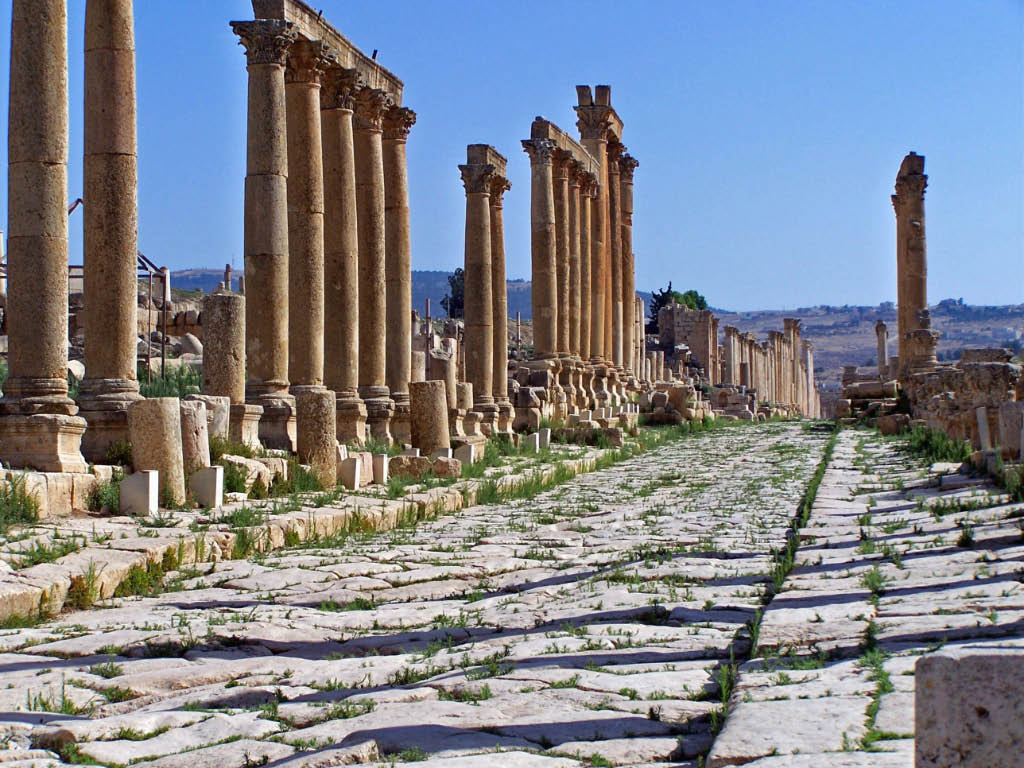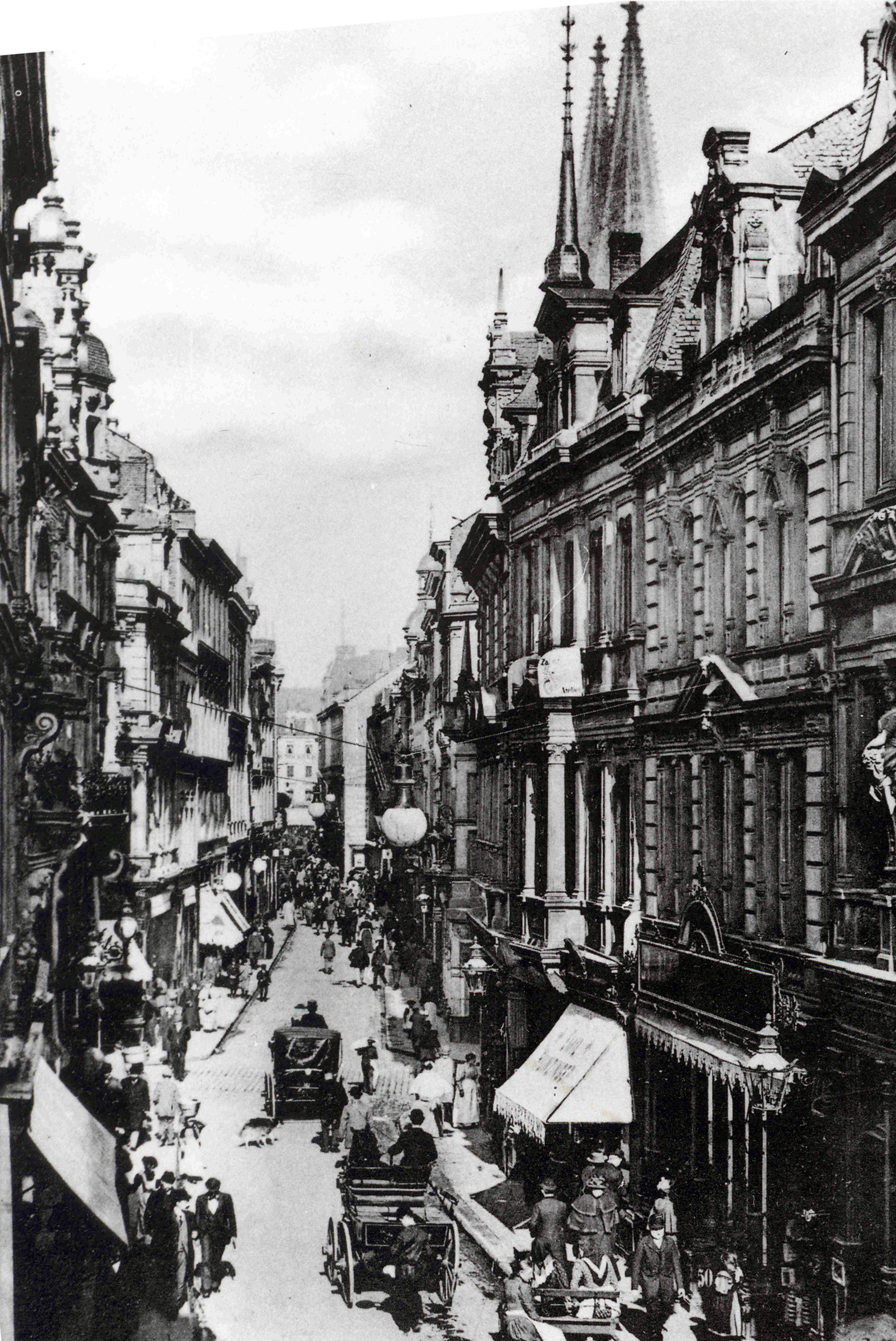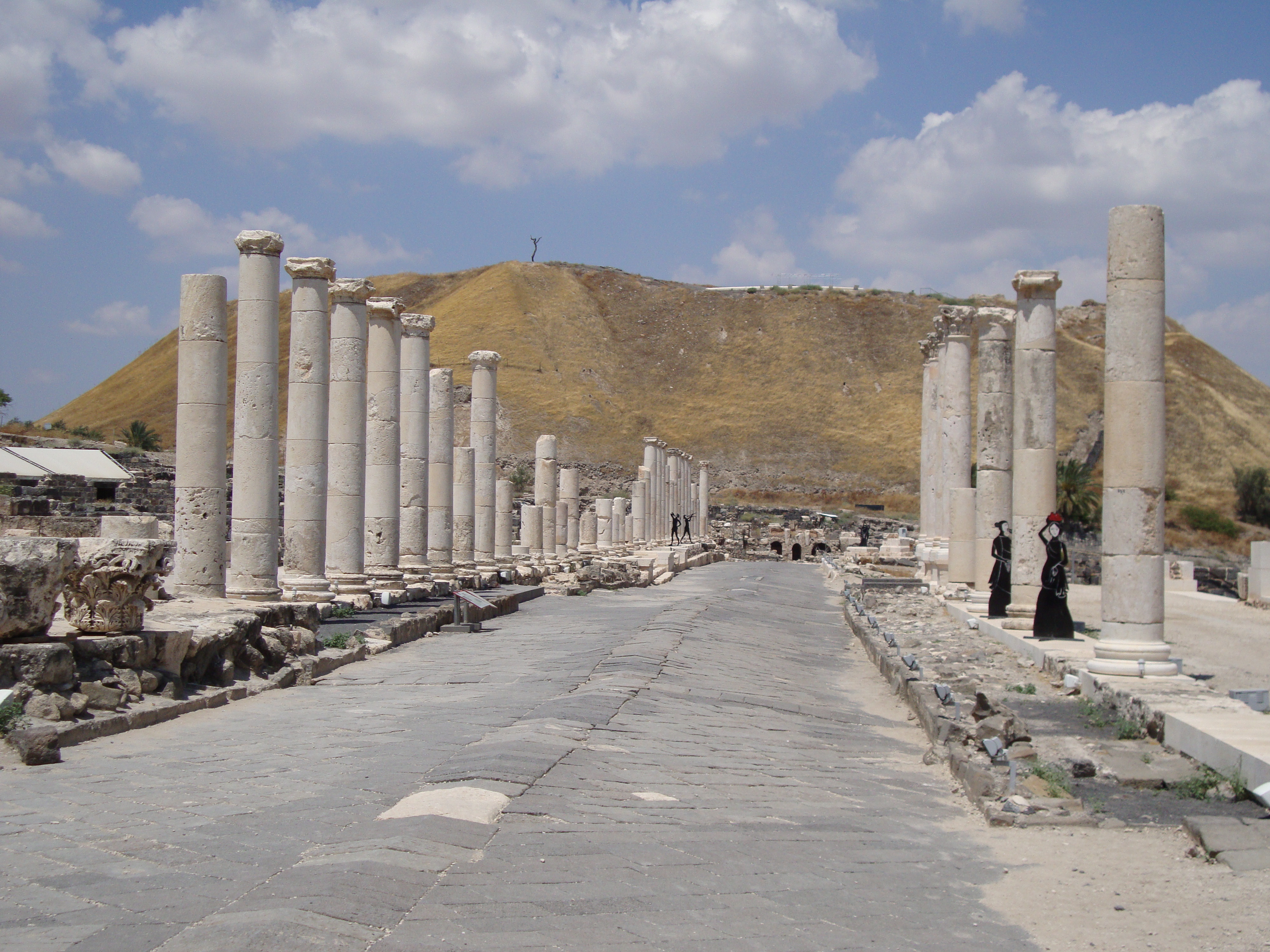Cardo maximus on:
[Wikipedia]
[Google]
[Amazon]
 A cardo (plural ''cardines'') was a north–south street in Ancient Roman cities and military camps as an integral component of
A cardo (plural ''cardines'') was a north–south street in Ancient Roman cities and military camps as an integral component of
 The Cardo Maximus of Apamea, Syria ran through the centre of the city directly from North to South, linked the principal gates of the city, and was originally surrounded by 1200 columns with unique spiral fluting, each subsequent column spiralling in the opposite direction. The thoroughfare was about 1.85 kilometres long and 37 metres wide, as it was used for wheeled transport. The great colonnade was erected in the 2nd century and it was still standing until the 12th. The earthquakes of 1157 and 1170 demolished the colonnade. The cardo was lined on both sides with civic and religious buildings.
The Cardo Maximus of Apamea, Syria ran through the centre of the city directly from North to South, linked the principal gates of the city, and was originally surrounded by 1200 columns with unique spiral fluting, each subsequent column spiralling in the opposite direction. The thoroughfare was about 1.85 kilometres long and 37 metres wide, as it was used for wheeled transport. The great colonnade was erected in the 2nd century and it was still standing until the 12th. The earthquakes of 1157 and 1170 demolished the colonnade. The cardo was lined on both sides with civic and religious buildings.
 Hohe Strasse and
Hohe Strasse and

 During the visit of Hadrian to
During the visit of Hadrian to 
Cardo Street
on a Jerusalem photo portal
Cardo Virtual Tour
{{Webarchive, url=https://web.archive.org/web/20080116232009/http://www.3disrael.com/jerusalem/cardo_inside.cfm , date=16 January 2008 Ancient Roman city planning Classical sites in Jerusalem Meridians (geography) Geopositioning markers
 A cardo (plural ''cardines'') was a north–south street in Ancient Roman cities and military camps as an integral component of
A cardo (plural ''cardines'') was a north–south street in Ancient Roman cities and military camps as an integral component of city planning
Urban planning, also known as town planning, city planning, regional planning, or rural planning, is a technical and political process that is focused on the development and design of land use and the built environment, including air, water, ...
. The cardo maximus, or most often the ''cardo'', was the main or central north–south-oriented street.
Etymology
The ''cardo maximus'' was the "hinge" or axis of the city, derived from Greek καρδίᾱ, kardia ("heart") and as such was generally lined with shops and vendors, and served as a hub of economic life. Most Roman cities also had aDecumanus Maximus
In Roman urban planning, a decumanus was an east–west-oriented road in a Roman city or castrum (military camp). The main decumanus of a particular city was the Decumanus Maximus, or most often simply "the Decumanus". In the rectangular street g ...
, an east–west street that served as a secondary main street. Due to varying geography, in some cities the Decumanus is the main street and the Cardo is secondary, but in general the Cardo maximus served as the primary street. The Forum was normally located at, or close to, the intersection of the Decumanus and the Cardo.
Examples
Apamea, Syria
 The Cardo Maximus of Apamea, Syria ran through the centre of the city directly from North to South, linked the principal gates of the city, and was originally surrounded by 1200 columns with unique spiral fluting, each subsequent column spiralling in the opposite direction. The thoroughfare was about 1.85 kilometres long and 37 metres wide, as it was used for wheeled transport. The great colonnade was erected in the 2nd century and it was still standing until the 12th. The earthquakes of 1157 and 1170 demolished the colonnade. The cardo was lined on both sides with civic and religious buildings.
The Cardo Maximus of Apamea, Syria ran through the centre of the city directly from North to South, linked the principal gates of the city, and was originally surrounded by 1200 columns with unique spiral fluting, each subsequent column spiralling in the opposite direction. The thoroughfare was about 1.85 kilometres long and 37 metres wide, as it was used for wheeled transport. The great colonnade was erected in the 2nd century and it was still standing until the 12th. The earthquakes of 1157 and 1170 demolished the colonnade. The cardo was lined on both sides with civic and religious buildings.
Cologne, Germany
 Hohe Strasse and
Hohe Strasse and Schildergasse __NOTOC__
The Schildergasse (; ksh, Schelderjaß ) is a shopping street in central Cologne, Germany. With 13,000 people passing through it every hour, it is the busiest shopping street in Europe, according to a 2008 survey by GfK. Kölner Stadt ...
in Cologne
Cologne ( ; german: Köln ; ksh, Kölle ) is the largest city of the German western state of North Rhine-Westphalia (NRW) and the fourth-most populous city of Germany with 1.1 million inhabitants in the city proper and 3.6 millio ...
, Germany, may be taken as examples of streets that have kept their course and function of Cardo and Decumanus Maximus until this day.
Jerash, Jordan
The excavations atJerash
Jerash ( ar, جرش ''Ǧaraš''; grc, Γέρασα ''Gérasa'') is a city in northern Jordan. The city is the administrative center of the Jerash Governorate, and has a population of 50,745 as of 2015. It is located north of the capital city ...
in Jordan have unearthed the remains of an ancient Roman city on the site, with the mains feature of the city being a colonnaded cardo. The original road surface survived.
Jerusalem
 During the visit of Hadrian to
During the visit of Hadrian to Judea
Judea or Judaea ( or ; from he, יהודה, Standard ''Yəhūda'', Tiberian ''Yehūḏā''; el, Ἰουδαία, ; la, Iūdaea) is an ancient, historic, Biblical Hebrew, contemporaneous Latin, and the modern-day name of the mountainous sou ...
in the 130s AD, Jerusalem's ruins were surveyed and Hadrian decided to build a Roman colony in its place, naming it Colonia Aelia Capitolina
Aelia Capitolina (Traditional English Pronunciation: ; Latin in full: ) was a Roman colony founded during Emperor Hadrian's trip to Judah in 129/130, centered around Jerusalem, which had been almost totally razed after the siege of 70 CE. The f ...
, after the Roman deities Jupiter
Jupiter is the fifth planet from the Sun and the largest in the Solar System. It is a gas giant with a mass more than two and a half times that of all the other planets in the Solar System combined, but slightly less than one-thousandth t ...
, Juno and Minerva
Minerva (; ett, Menrva) is the Roman goddess of wisdom, justice, law, victory, and the sponsor of arts, trade, and strategy. Minerva is not a patron of violence such as Mars, but of strategic war. From the second century BC onward, the Rom ...
(the Capitoline Triad
The Capitoline Triad was a group of three deities who were worshipped in ancient Roman religion in an elaborate temple on Rome's Capitoline Hill (Latin ''Capitolium''). It comprised Jupiter, Juno and Minerva. The triad held a central place in th ...
), worshiped at the Capitoline Hill
The Capitolium or Capitoline Hill ( ; it, Campidoglio ; la, Mons Capitolinus ), between the Forum and the Campus Martius, is one of the Seven Hills of Rome.
The hill was earlier known as ''Mons Saturnius'', dedicated to the god Saturn. ...
temple in Rome. Like many Roman colonies, Aelia Capitolina was laid out with a Hippodamian grid plan of narrower streets and wider avenues. Notably, the decision was one of the main causes of the Bar Kokhba revolt, which shortly encompassed the region.
The main north–south thoroughfare, the Cardo Maximus, was originally a paved avenue approximately 22.5 meters wide (roughly the width of a six lane highway) which ran southward from the site of the Damascus Gate, terminating at an unknown point. The southern addition to the Cardo, constructed under Justinian
Justinian I (; la, Iustinianus, ; grc-gre, Ἰουστινιανός ; 48214 November 565), also known as Justinian the Great, was the Byzantine emperor from 527 to 565.
His reign is marked by the ambitious but only partly realized ''renovat ...
in the 6th century AD, extended the road further south to connect the Church of the Holy Sepulchre with the newly built Zion Gate
Zion Gate ( he, שער ציון, ''Sha'ar Zion'', ar, باب صهيون, ''Bab Sahyun''), also known in Arabic as Bab Harat al-Yahud ("Jewish Quarter Gate") or Bab an-Nabi Dawud ("Prophet David Gate"), is one of the seven historic Gates of the Ol ...
. Along its length, the roadway was divided into three parts: two colonnaded covered walks flanking a 12 meter wide road. The shaded porticoes provided separation of pedestrian traffic from wheeled carts, shelter from the elements, space for small-scale commerce, as well as opportunities for residents and visitors to gather and interact. The central open pavement provided commercial access as well as ritual space. The Cardo's most striking visual feature was its Colonnade
In classical architecture, a colonnade is a long sequence of columns joined by their entablature, often free-standing, or part of a building. Paired or multiple pairs of columns are normally employed in a colonnade which can be straight or cur ...
, clearly depicted on the Madaba Map.
Simple bases supported monolithic shafts, spaced 5.77 meters apart. The shafts supported Byzantine-style Corinthian capitals – intricately carved, but more stylized versions of their Classical counterparts. Although this combination of elements was uniform the preserved examples display some variation in the profile and size of the bases, and in the pattern of the capitals. Despite aesthetic differences, the approximate height of the base, column, and capital units of the colonnade was five meters, a height which contributed to the spaciousness of the porticoes. The wall of the Cardo's eastern portico featured an arcade that housed various stalls and workshops leased by craftsmen and merchants.
The line of the Cardo Maximus is still visible on the Jewish Quarter Street, though the original pavement lies several meters below the modern street level. In the 7th century, when Jerusalem fell under Muslim rule, the Cardo became an Arab-style marketplace. Remains of the Byzantine Cardo were found in the Jewish Quarter excavations beginning in 1969.
In 1971, a plan for preserving the ancient street was submitted by architects Peter Bogod, Esther Krendel and Shlomo Aronson. Their proposal relied heavily on the sixth century Madaba map, a mosaic map of Jerusalem found in 1897 in Madaba, Jordan
Jordan ( ar, الأردن; tr. ' ), officially the Hashemite Kingdom of Jordan,; tr. ' is a country in Western Asia. It is situated at the crossroads of Asia, Africa, and Europe, within the Levant region, on the East Bank of the Jordan Rive ...
. The map clearly showed the Roman Cardo as the main artery through the Old City. The architects proposed a covered shopping arcade that would preserve the style of an ancient Roman street using contemporary materials. Their plan was based on the hope that archeologists would find remains of the southern end of the Cardo, an extension of the north–south Roman thoroughfare built during the Byzantine era (324–638).
Time was of the essence and mounting pressure to repopulate the Jewish Quarter led to the construction of a superstructure which allowed the residential buildings to be built while the archaeologists continued to work below. The project was 180 meters in total and was divided into eight sections to allow for construction teams to move quickly from one section to another. By 1980, 37 housing units and 35 shops were built, incorporating archaeological finds such as a Hasmonean wall from the second century BC and rows of Byzantine
The Byzantine Empire, also referred to as the Eastern Roman Empire or Byzantium, was the continuation of the Roman Empire primarily in its eastern provinces during Late Antiquity and the Middle Ages, when its capital city was Constantinopl ...
columns. The combination of old and new is also visible on the Street of the Jews, where the shops have been set into old vaults and the gallery is covered by an arched roof containing small apertures to allow for natural lighting.
Beit She'an, Israel
Beit She'an
Beit She'an ( he, בֵּית שְׁאָן '), also Beth-shean, formerly Beisan ( ar, بيسان ), is a town in the Northern District of Israel. The town lies at the Beit She'an Valley about 120 m (394 feet) below sea level.
Beit She'an is be ...
was one of a group of 10 Hellenistic
In Classical antiquity, the Hellenistic period covers the time in Mediterranean history after Classical Greece, between the death of Alexander the Great in 323 BC and the emergence of the Roman Empire, as signified by the Battle of Actium in ...
cities known as Decapolis
The Decapolis (Greek: grc, Δεκάπολις, Dekápolis, Ten Cities, label=none) was a group of ten Hellenistic cities on the eastern frontier of the Roman Empire in the Southern Levant in the first centuries BCE and CE. They formed a group ...
on the eastern frontier of the Roman Empire in Syria and Judea. It was a self-governed city established by the Romans to promote Roman culture. It was built with a central cardo, temples, theaters, baths and other public buildings, and minted its own coins.
Beirut, Lebanon
The Cardo Maximus was the main north–south street of Roman Berytus. A section of the street – 100 meters long or so – was discovered during excavation works, flanked by two rows of limestone pedestals. These pedestals once carried 6-meter-high columns supporting roofed colonnades on either side of the street. A stairway in the eastern colonnade gave access to a large building complex. The Cardo Maximus connected the Forum to another complex that extended from the present Al-Azariyeh building to Riad Al Solh Square. Archaeological excavations uncovered two successive levels of the street, the oldest dating to the 2nd century CE. The later, wider street was laid out during the 4th century A.D. The floors of the colonnades on both levels of the Cardo Maximus were embellished with mosaic pavements. These were covered, in the 6th century CE., with a thin coat of white lime plaster. Fragments of the floors remained in use until the 19th century. Roman columns were re-used in the foundations of later buildings constructed within the pavement of the Cardo, reducing the main street of Roman Berytus into a small alley.Saghieh-Beydoun, Muntaha, 'Allam, Mahmoud, 'Ala’Eddine, Abdallah and Abulhosn, Sana (1998-9) "The Monumental Street 'Cardo Maximus' and the Replanning of Roman Berytus", Bulletin d’Archéologie et d’Architecture Libanaises 3:95-126.Poreč, Croatia
In the seaside resort of Poreč, Croatia, both Cardo Maximus and Decumanus have retained their original names and still serve as the main streets of the historic town centre.References
Further reading
* Avigad, N. 1984. Discovering Jerusalem. London: Basil Blackwell. *Bahat, D. 1990. The Illustrated Atlas of Jerusalem, translated by S. Ketko. New York and London: Simon and Schuster. *Bosanquet, R. C. 1915. "Greek and Roman Towns I: Streets". The Town Planning Review, Vol. 5, No. 4: 286–93. *Chen, D. 1982. "Dating the Cardo Maximus in Jerusalem". Palestine Exploration Quarterly, Vol. 114, January–June: 43–45. *Geva, Hillel, ed. 2000. Jewish Quarter Excavations in the Old City of Jerusalem, Vol. 1. Jerusalem: Israel Exploration Society and Institute of Archaeology, Hebrew University. *Golan, D. 1986. "Hadrian’s decision to supplant 'Jerusalem' by 'Aelia Capitolina". Zeitschrift für Alte Geschichte, Vol. 35, No. 2: 226–39. *Jones, A.H.M. 1955. "The Economic Life of the Towns of the Roman Empire". Recueils de la Societe *Jean Bodin, VII: la ville. Brussels: La Librairie Encyclopedique. *Kennedy, Hugh. 1985. "From Polis to Madina: Urban Change in Late Antique and Early Islamic Syria". Past and Present, Vol. 106: 3–27. *Ward Perkins, J. B. 1955. "Early Roman Towns in Italy". The Town Planning Review, Vol. 26, No. 3: 126–54.External links
Cardo Street
on a Jerusalem photo portal
Cardo Virtual Tour
{{Webarchive, url=https://web.archive.org/web/20080116232009/http://www.3disrael.com/jerusalem/cardo_inside.cfm , date=16 January 2008 Ancient Roman city planning Classical sites in Jerusalem Meridians (geography) Geopositioning markers